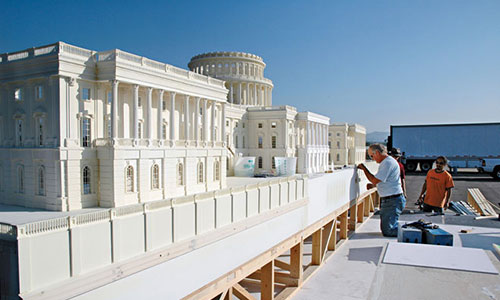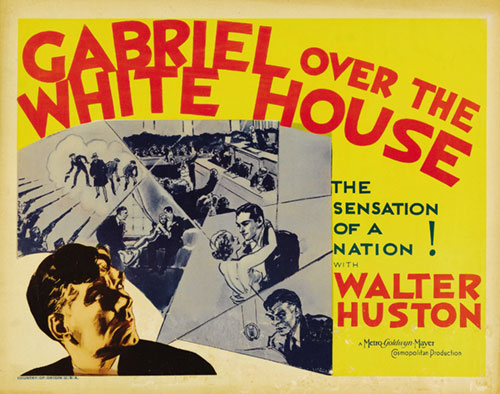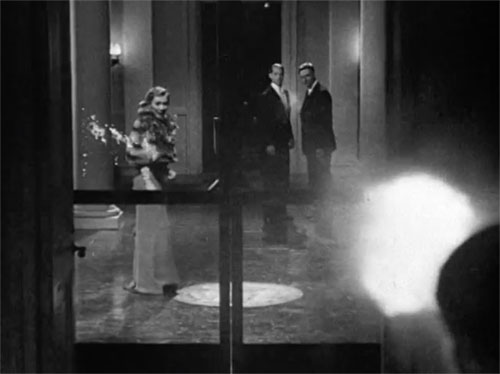Let’s Destroy the White House … Again
The film Independence Day is known for an epic scene in which the White House is turned into small chunks of America. How did they do that?
(Editor's Note: In honor of the release of Independence Day: Resurgence, the sequel to the popcorn-flick classic, we're re-running one of our favorite issues, which is about the best scene in that movie. We've expanded it with a whole new section; consider it a director's cut. So if you remember it from last time, keep reading anyway.)
three

How Independence Day pulled off that iconic White House explosion shot
For such a impactful explosion, it wasn't actually all that large in size.
See, Independence Day—released at a point when CGI was still relatively young—took the art of model design and put it into overdrive to give the special effects the extra push they needed.
Other parts of the movie went kaboom in miniature as well, but the White House easily had the greatest amount of detail—which is why it's so memorable. It was a 5-foot-tall 1:24 scale model—a replica that was essentially built to be destroyed. To give you an idea of how small that is, here's a similarly scaled White House model.
"The White House has got such great detail in it that even in the most preliminary tests that we've done, that the White House holds up in extreme close-up," visual effects director Bob Hurrie noted in a making-of video for Independence Day. "So, all of a sudden, this particular miniature is very near and dear to our hearts because it's got such wonderful detail. I don't know if I really wanna blow it up or not!"
The model, built of plaster and molded manually, looks impressively like the real thing despite its small size. But in ways relevant to the filming, that small scale had some key differences that a full-size building wouldn't—particularly, that it goes ablaze extremely quickly.
The solution to this issue is a combination of visual trickery and mathematics. The model was shot with nine different cameras at a variety of speeds, at a total speed of 305 frames per second.
As a result, a scene that lasted about eight seconds in the film itself only took about a second to shoot, and was then slowed down to the speed necessary for it to look natural to the human eye.
The finished scene was so realistic that Emmerich had to actually edit the scene slightly so people realized that the president and his family were able to get away from the exploding White House unscathed. Not bad for a building the size of a Barbie dream house.
Five ways TV and film productions made the White House their own house
- To better allow for the walk-and-talks that the show traded in, The West Wing had a single floor with wide hallways, despite the fact that the actual west wing of the White House has two floors.
- The film Idiocracy's White House has a memorably white-trashy exterior, with a swimming pool, satellite dish, and tire swing depicted outdoors. The infamous "Brawndo's got what plants crave" scene also shows a White House conference room with some particularly hilarious renovation work.
- If you're watching the show Scandal expecting an accurate White House display, you'll be sorely disappointed. The website Seeing Stars notes that much of the show is shot around the Los Angeles area.
- Likewise, House of Cards films many of its scenes in Baltimore, a city with architecture that looks enough like D.C. that the crew can kind of pull it off.
- The 2012 film Abraham Lincoln Vampire Hunter had no chance of being the most historically accurate film about Abraham Lincoln released in 2012 (look to Lincoln for that), but the film did take care to offer up historical touches to give the film its 19th-century feel. Production designer François Audouy says they shot the White House interior scenes in New Orleans' former city hall. That's cool. Not so cool, however, is the film's use of CGI for the exterior shots.
"In fact, our pilot’s Oval Office walls were used on The West Wing, and those on the permanent set were in a Nicolas Cage movie — I know this because I saw the words ‘National Treasure’ written in Sharpie on the back of them."
— Jason Winer, director of the single-season NBC family comedy 1600 Penn, which featured Josh Gad as the awkward son of the First Family (and president emeritus Bill Pullman doing the job he was born to do), discussing the set design of the show, which was inspired by an actual trip to the White House. As you can imagine due to the popularity of the subject in film and literature, sets for different White Houses get recycled frequently for different films. For example, the Oval Office created for the film Dave also showed up in Hot Shots Part Deux and Clear and Present Danger, while the Oval Office created for the Aaron Sorkin-written The American President had a lengthy second life in Sorkin's The West Wing, along with Nixon and Independence Day.

The first movie about a fictional president imagined FDR as a fascist dictator that everyone loves
Here's an interesting factoid that you can use for a trivia night coming up soon: Despite the fact that fictional presidents have become a popular trope of pop culture for generations, especially in film, nobody actually came up with the idea of creating a movie about one until the 1930s.
That's right—the pre-talkie era didn't lead to a single film that imagined the potential of a leader who looked nothing like the one in office at the time. (Maybe people really liked Herbert Hoover? Oh … yeah. Nevermind.)
The Great Depression, however, created a perfect opportunity for such a film—and that film, 1933's Gabriel Over the White House, is very much not a crowd-pleaser in the Independence Day sense.
I was inspired to watch it because I heard it featured a drive-by shooting scene at the White House. But I found something much weirder than that unusual idea suggests on its own. Gabriel is a bizarre, radical propaganda film, funded by William Randolph Hearst (who was supportive of fascism at the time) and creatively influenced by Franklin Delano Roosevelt (who was reportedly a fan of the movie). The film imagines its leader, President Judson Hammond, as a powerful, noble public official. Played by Walter Huston, who previously portrayed Abraham Lincoln on screen in a D.W. Griffith film, Hammond had a strongly presidential vibe.
But Hammond didn't start out that way. First, he was a corrupt do-nothing along the lines of Warren G. Harding, and then, after a car wreck (caused by him, of course), he ends up in a coma. Expected to die, he instead is imbued with the spirit of the archangel Gabriel and miraculously recovers … and becomes an FDR-style leader who quickly introduces a series of social welfare programs. (Done, it should be said, before FDR himself had the chance to do the same in real life.)
When an army of unemployed people become a problem in Baltimore, he's told to use tanks to control the crowd; instead, he stops in and promises a broad-reaching set of programs to give them jobs. Sounds pretty good so far, right?
Unfortunately, he doesn't stop there. When members of his cabinet hold a secret meeting to undermine him, he forces all of them to resign. When Congress won't abide by his plans, he convinces Congress to vote to disperse, effectively making him a dictator.
But he's the good kind of dictator, of course: He just wants to help the country. In an effort to end prohibition, he nationalizes the sale of alcohol, pissing off a character who's basically Al Capone under a different name.

This leads to a drive-by shooting at the White House, because you can just drive up to the White House in 1933 with an automatic weapon. (A GIF of it is here in case you'd like to watch it that way.) That was a bad idea, Al Capone wannabe, because it simply convinced President Hammond to launch a Brownshirt-style police force that blows up the illegal distillery, arrests the gangsters, puts them on display in a show trial, and then executes them by firing range.
Pretty crazy, right? Well, it's nothing compared to the final minutes of the film, where he convinces every world leader that the U.S. military is too powerful to stop, so they should agree to world peace on President Hammond's terms … and then pay back all the money they owe the U.S.
Then, after every country in the world signs Hammond's contract, he dies, but not before he's called "one of the greatest men who ever lived," because fascism is awesome, right?
Independence Day had Will Smith punching out an alien and a scene where Jeff Goldblum took down an alien mothership with a Powerbook 5300, and it somehow seems more realistic than Gabriel Over the White House, which was funded by William Randolph Hearst at the nadir of the Great Depression to convince people that fascism was a noble cause. (Great timing there, considering that Hitler completed his rise to power around the time the film was released.)
Gabriel isn't realistic; it just feels like it's applicable to real life at times. The film, before running into Hays Code censors of the era, was supposedly at one time even more extreme than what ended up on the screen.
It's understandable, considering all that, why the film is impossible to find on any streaming service.
Films aren't the only place where you'll find replicas of the White House. In fact, people have been building their own versions of the president's mancave (and potential ladycave) for years, including a 3/4-size replica that was built by an Iranian immigrant after he moved to Atlanta.
And if you're not in the United States, no worries, you're in luck: In China, bold developers have been creating their own White House replicas for years, some costing as much at $10 million. All those set designers seem like they aren't trying hard enough in that context.
So, note to President Whitmore: If you find your version of the White House suddenly uninhabitable due to aliens, head down to McLean in Virgnia. There's a perfectly serviceable replica there, ready for all your needs.
:format(jpeg)/2018/01/cah5jgwedslkcgttjrfc--1---1-.gif)
/2018/01/cah5jgwedslkcgttjrfc--1---1-.gif)

/uploads/ernie_crop.jpg)